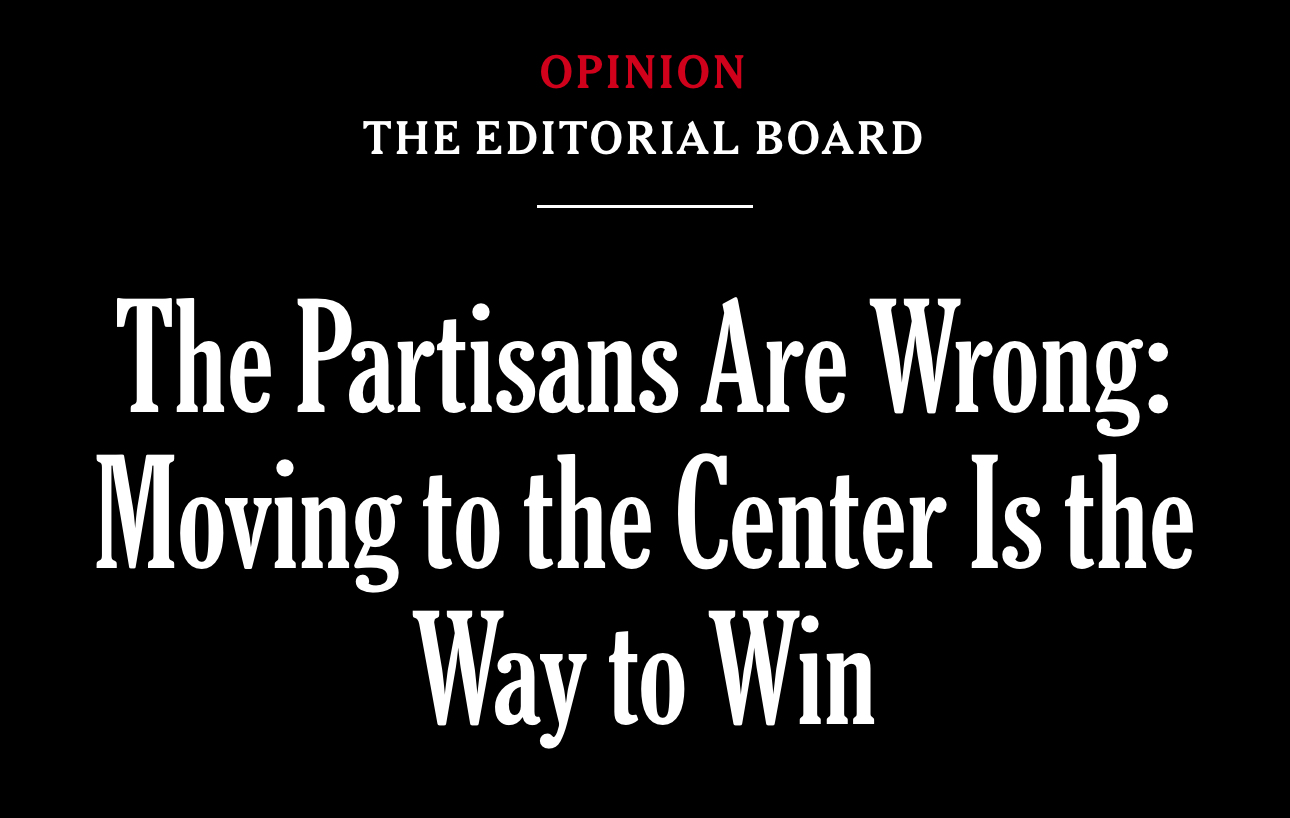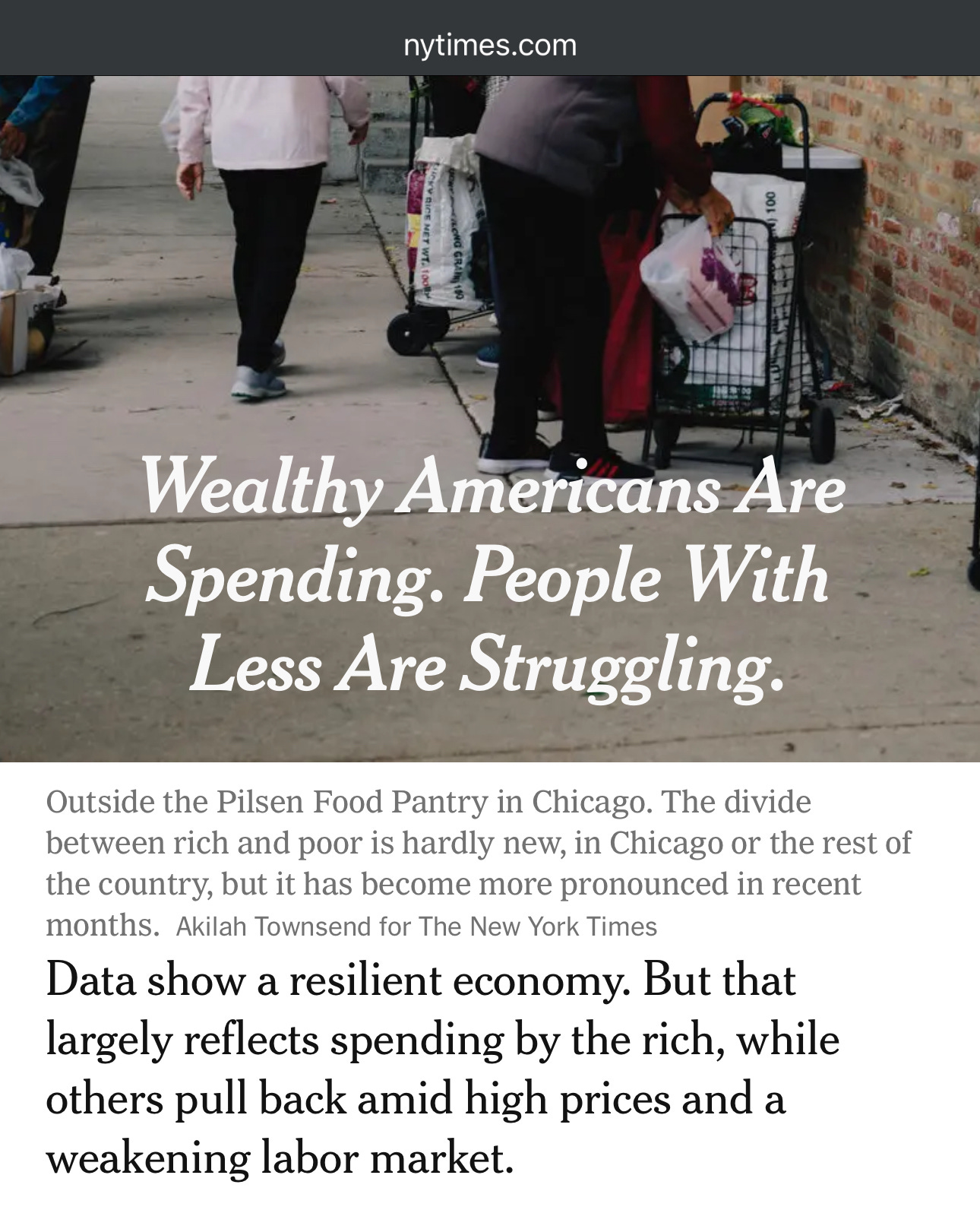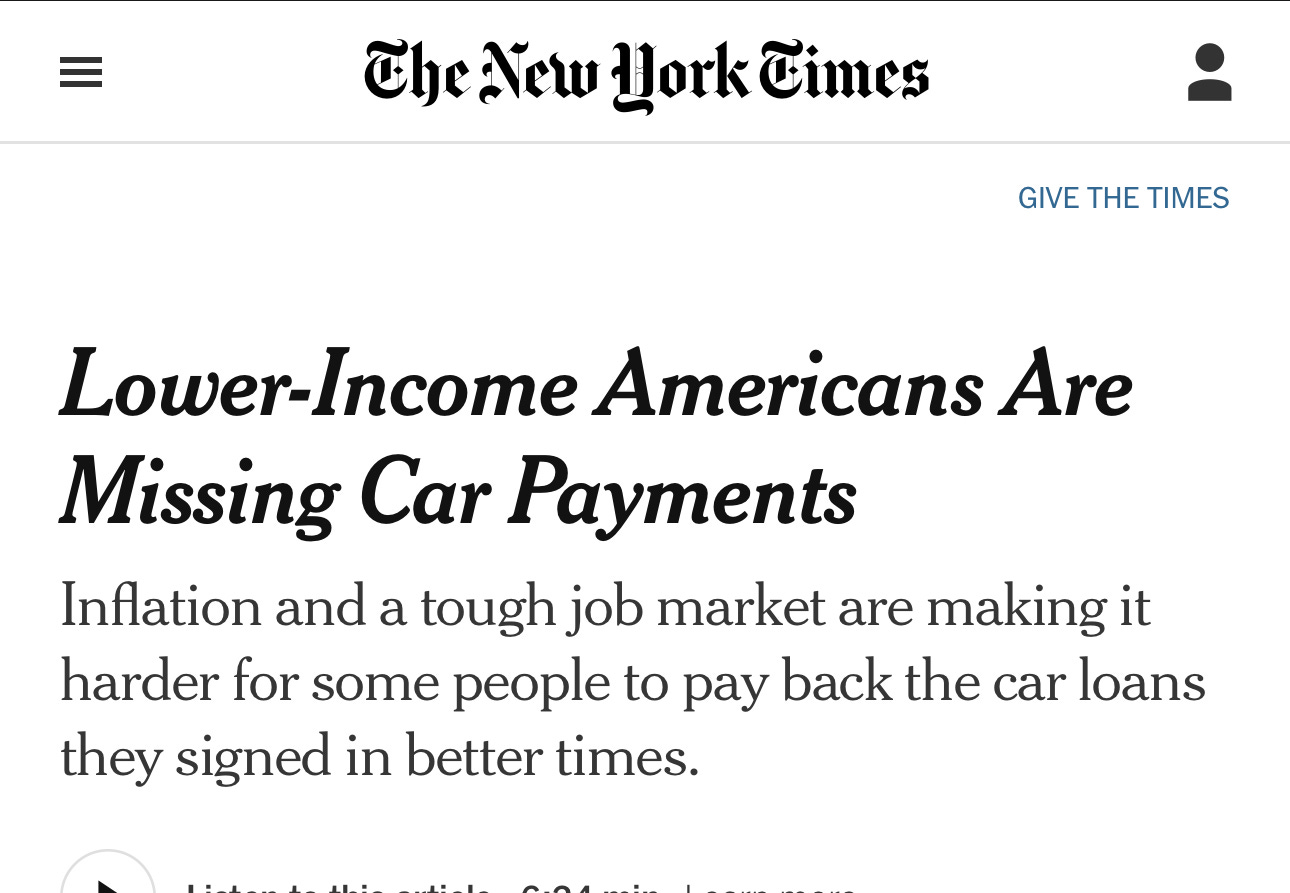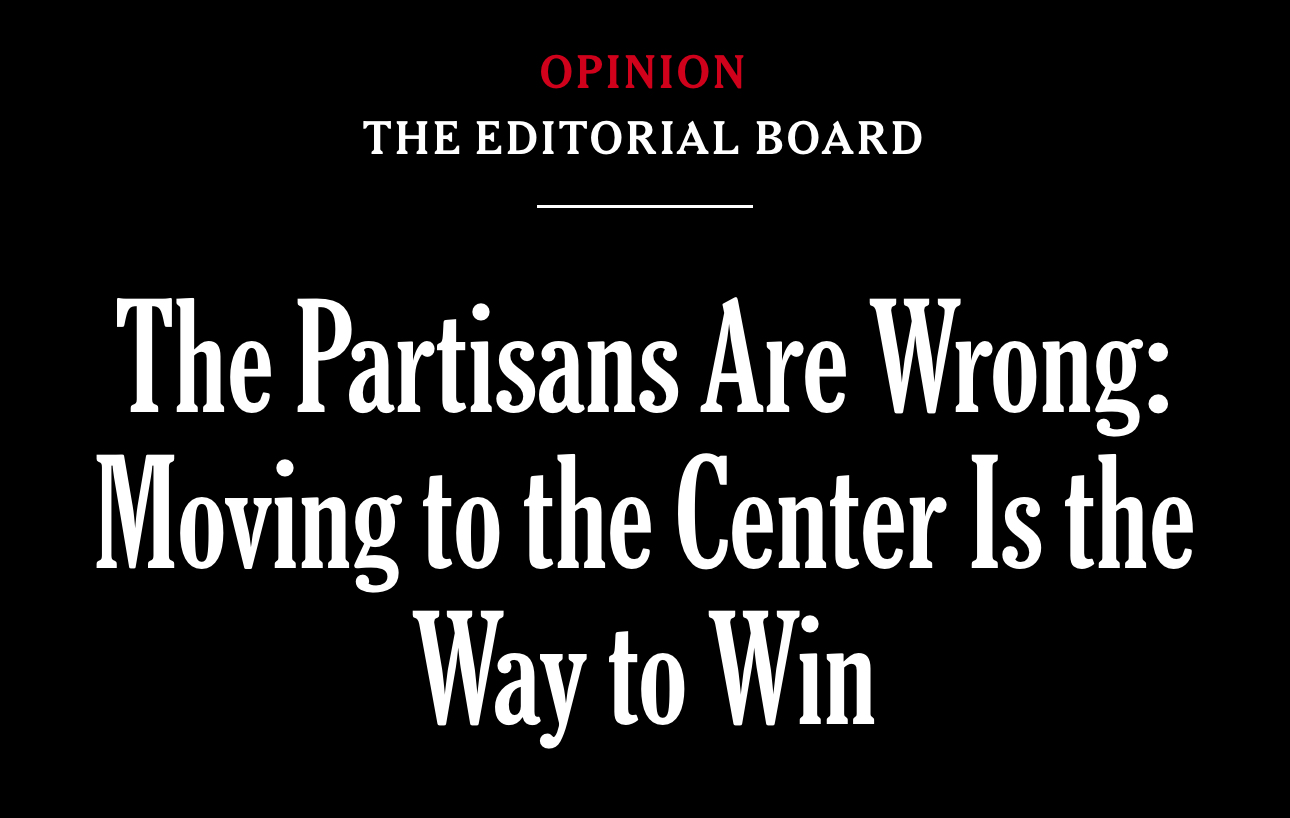The Dangerous Delusion of the Center
The NYT Editorial Board is suggesting a dangerous electoral path
Well the NYTs keeps putting out bangers this week. This is not the way. Below I make my case.
There’s a story the powerful tell themselves when things get shaky. We’re hearing it everywhere right now—in our feeds, in the halls of power, printed in the pages of our most respected newspapers. It’s comforting, simple, and it’s a lie.
The New York Times Editorial Board just published a perfect example. Faced with rising authoritarianism and a country cracking at the seams, they offered their grand solution: centrism. “Candidates closer to the political center,” they wrote, “continue to fare better in most elections.” The antidote to Trump, they assure us, is “a creative, re-energized political center.”
Let’s be clear about what this is. This is the establishment’s emergency brake—the advice they give when terrified of the monster the system creates. The problem is they’re more terrified of the changes required to defeat the monster than of the monster itself.
It’s easier to prescribe sedatives than to diagnose and treat the disease. After all, the culprit is the very system from which they benefit.
The editorial board’s advice isn’t just wrong. It’s a repetition of the most dangerous mistake in history.
Deconstructing the Lie
Before we get to the truth, let’s dismantle the fiction. The Times builds its case on sand. Their evidence? A chart showing “moderate” candidates do better in elections. But how do they define “moderate”?
By who gives them money.
Here’s their methodology: “We defined House candidates as moderate… based on the groups that supported their campaigns. Candidates who received money from centrist groups like the Blue Dog PAC counted as moderates.”
This doesn’t measure a candidate’s beliefs. It measures their ability to fundraise from the corporate-friendly establishment. It measures who’s willing to play the game.
They aren’t proving that moderate *policies* win. They’re proving that candidates who secure establishment backing tend to be better funded, face weaker opponents, or benefit from any number of advantages that come with institutional support. Their methodology can’t distinguish between these possibilities—and they don’t even try.
Even more telling is what they actually recommend. The Times admits that traditional moderation doesn’t work anymore. Instead, they champion “angry centrism”—a “combative and populist” style that “promises sweeping change while criticizing the two parties as out of touch.”
Let me quote them directly: “Rather than locating itself midway between the two parties, this new centrism promises sweeping change while criticizing the two parties as out of touch.”
They are openly advocating for performative populism. Run like a revolutionary, govern like a manager of the status quo. Adopt anti-establishment language to win, then channel that energy right back into the same broken system.
It’s a bait-and-switch. A political con game. And here’s the danger they won’t acknowledge: when those voters discover they’ve been conned, they’ll be even more convinced that democracy doesn’t deliver. You’ll have a whole generation who voted for transformation and got a return to 2015. That’s not a path away from authoritarianism—it’s an expressway toward it.
The Sickness Isn’t Trump. It’s the Rot
In a previous essay, I used a metaphor: American democracy has comorbidities. Trump is the virus. Our comorbidities are the economic desperation created by forty years of bipartisan policy failure.
The Times looks at this patient and prescribes moderation. What they’re really saying is: “Don’t treat the underlying disease. That might require changing the system we’ve spent decades building.”
Let’s do the math on that disease. Since the late 1970s, productivity has shot up nearly 60%. Wages? Up less than 14%. You’ve been working harder and smarter while your share gets systematically stolen and handed to the top.
Housing: In 1970, the median home cost 3 times median income. Today it’s over 5 times.
Healthcare: We spend $14,885 per person—double other wealthy countries—for worse outcomes and lower life expectancy.
Childcare: In 45 states, it costs more than the average mortgage for two kids.
This is the reality the Times refuses to confront. They call the system that produced this wreckage “normal.” They call it “the center.” And they tell us the solution is moving back toward it.
Why They Can’t See It
The Times can’t see the structural failure because of who populates these institutions. When your editorial board, your expert class, your consultant pool all come from the same narrow slice of educated, credentialed, economically comfortable America, you lose the ability to diagnose systemic collapse. You mistake your own stability for the system working. This isn’t about bad faith—it’s about a class position that makes certain truths invisible. They aren’t looking for diversity of thought or experience. They’re looking for people who look different but think the same.
And so they offer advice that serves their class interests: contain the threat, preserve the system, manage the decline. They think they can control this authoritarian moment without addressing the rot that produced it. They’re wrong.
The Only Antidote Is Transformation
We have to reject this logic completely. Moving to the “center”—defending an economic system that has failed the majority—is not a strategy. It’s surrender.
The only way to defeat fake populism is with real, transformative economic populism. The only way to restore faith in democracy is to make it deliver.
Look at who actually breaks through: Obama in 2008 running on Hope and Change. Bernie Sanders building a movement. Trump promising to blow up the system. The Tea Party. AOC. What united them wasn’t moderation—it was a clear promise that things would fundamentally change.
This means saying loudly what we are FOR: Rebuilding state capacity. Government as employer, general contractor, and competitor to private monopolies. Public housing, public healthcare, public infrastructure—not as welfare, but as investment in our collective strength.
These ideas are overwhelmingly popular. 69% of Americans—including 62% of Republicans—want the government to break up monopolies. Support for unions is at a 60-year high. 76% of voters support the government manufacturing generic drugs to lower prices.
The people are already there. They’re not demanding moderation—they’re demanding fundamental change to the daily math of their survival.
The Historical Warning
The Times’s advice pushes us toward the same cliff that consumed Weimar Germany. Faced with economic desperation and rising authoritarianism, German liberals chose to defend the economic status quo rather than embrace transformation. When forced to choose between economic reform and alignment with the authoritarian right, they chose the right. Why? Because preserving capital and class hierarchy was more important to them than defeating fascism.
We’re watching the same choice being made right now. The establishment thinks it can contain this authoritarian movement without addressing the system that created it. They’re wrong. What they’re actually doing is ensuring the next one will be better trained and more successful. They may put money in people’s pockets instead of their own. If Trump were doing that, we’d be fucked.
Real Respect
The Times ends by saying moderation is about respect—that politicians shouldn’t “dismiss views held by most Americans as uninformed.”
They’re right. But here’s what most Americans actually believe: that the system is rigged, that they’re working harder and falling further behind, and that something fundamental needs to change.
The establishment hears this rage and says, “Let me redirect it safely back into the system that created it.” They’re advocating for manipulation, not respect.
Real respect means listening when people say the system is broken and actually fixing it. It means understanding that the real radical isn’t someone who wants change—it’s someone who insists on defending a system actively failing the majority.
The center is a delusion. The only way to defeat authoritarianism is to treat the comorbidities that make us vulnerable to it in the first place. The Times offers performative populism that preserves the status quo. We offer transformative economics that rebuilds the foundation.
History will judge which choice we made by the world our children inherit.
Corbin Trent







You are absolutely spot on. Unfortunately, the loudest voices are the ones with funds, megaphones and bullshit. We need new New Deal champions who will unite the working class. But the moneyed overlords still intend to carry the day by pitting left against right, and foolishly the uninformed will comply. It took the Great Depression to spur New Deal changes. We have much more to lose today if we have to wait for that impetus to wake people up.
Thanks Corbin — could not be better stated!
The Left-Right-Center focus tends to miss what is really going on: the Left tends to fixate on abstract ideals while paying insufficient attention to the day-to-day plight of the working class. Simply moving to center and rejecting “woke” won’t fix that.
To prevail, the Democratic Party needs to move in the Sanders/AOC/Mamdani direction. Again, I suggest starting with the tax policies promoted by Patriotic Millionaires: https://patrioticmillionaires.org/
Of course that would make the monied class wet their collective pants, but it’s an existential crossroads for the Party.